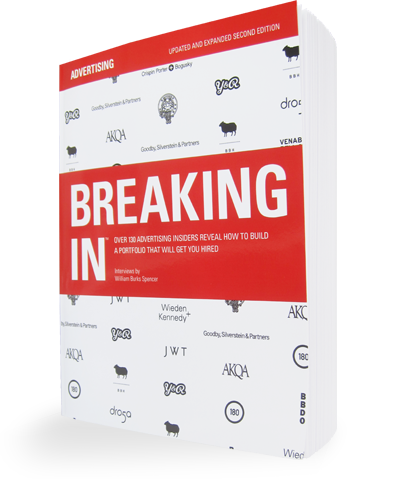If you missed it, check out some great work from Nicolas Roope.
WS: So what impresses you in a student portfolio website? What do you look for?
NR: Originality and raw ideas, and some ability to form them into something usable. Communication is really a mix of all kinds of things. It is a mix of some kind of idea or concept and then that is channeled in a way to deliver a message or persuade somebody to do something. So really the evidence of both those things is important, i.e., the ability to have ideas that feel fresh and interesting, and appropriate, relevant, and resonant. And then the ability to use those ideas as a kind of vehicle to deliver a message. It’s very, very simple.
A fluency with digital is also very important. Thinking digitally requires system thinking, which is never really there with traditional ad creatives. We don’t just put pictures and copy lines together, we’re designing complex applications to bring our ideas to life. If a creative can’t think that way then it’s a big limit on the scope of their thinking.
WS: Do you have writers and art directors or designers? What are the different creative roles you have here?
NR: We don’t have creative teams as such, we have a number of floating creatives who plug into different people for different types of briefs, a kind of “hot teaming”—like “hot desking.” It works like this because both problems and the solutions we have at our disposal are so broad that a single team would never be able to cover the necessary ground to think through every instance. One day they might sit with a strategist, the next a coder, the next an art director.
Poke does have art directors but not in the ad team sense. They’re attached to the design department, although, as I said, they get put into the conceptual, creative work too when it’s appropriate. We have a writing team too that works both on concept development and on the delivery side of things, so again, quite a different setup.
WS: So for what roles do you hire?
NR: Well, we hire conceptual creatives, writers. We hire strategists, information architects, user-experience people, designers, art directors, project managers, and engineers.
[ … ]
WS: Do you like to see online books that include things that aren’t necessarily websites, or even digital things? Or artwork, or products? Or just anything that just shows ideas?
NR: Yeah, definitely. I’m very drawn toward people who can’t not be creative. It’s not just a career for them; it’s something that’s sort of built into their bones. And so I think people like that just can’t not look at everything in their world and try to transform it in some way, or do something to it. I’m very reassured when I see that in a portfolio. In fact, I’ve hired a few people because of the stuff at the back of the book for that very reason.
We hired this junior designer a few years ago who didn’t actually have that much experience. He had just graduated. He was building interactive sculptures and really interesting installation pieces in his own time and out of the college context. And one of the things that he built was a radio piano. So every key that you pressed on the keyboard, it just played a different radio that was tuned into a different station. It was just conceptually a really nice idea. Not particularly amazing, technically. But as an idea, it was great. He was just compelled to do it and he followed it through because he was interested in it. It was a demonstration of his open-mindedness, core creativity, and driving passion. And sure enough, a few years later, he’s not just a really strong designer but someone who really shines.
WS: And what do you think is a good way to improve?
NR: I think from our point of view, the most important thing of all probably is a complete immersion in the digital world. Obviously talent is an important part as well. But I think immersion is critical. You forget, because we all live in the same world, that when a designer puts something together and sticks it on a poster, we’re all drawing on the same references. We all have this consensus. And so you can be very sophisticated in your language in the way that you build these communications. In digital, not everybody is conversant because we don’t all share the same histories as users; we’ve adopted at various stages and we’ve consumed very different experiences. But I think what’s absolutely true is that, just like our physical world is a culture, the online world is a different kind of culture. And it has its own set of rules and reference points. And not just in terms of conceptual reference points, but reference points in the way that things work, the way that different systems make you feel. So if people, designers or writers, or whoever you’re working with, aren’t immersed in that world, then they miss all that. And then the communications will simply be less effective.
When you see something that’s brilliant, it’s about condensing something down to something very sharp, and very focused, and single-minded. But what allows it to be so sharp is the way that it’s using those reference points to tell its story, if you like. So, in the absence of that, it’s not as strong. I think when you see a lot of stuff coming out of agencies that I don’t respect so much, a lot of it just feels crude. They feel very accomplished from a craft point of view but they feel crude in what they’re saying, and how they’re making it, and how they’re building the communication. The point is simply that really understanding the culture and being ingrained in it just makes the work much better.

Comments are closed.